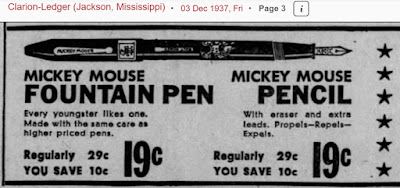This article has been edited and included in The Leadhead's Pencil Blog Volume 6, now on sale at The Legendary Lead Company. I have just a few hard copies left of the first printing, available here, and an ebook version in pdf format is available for download here.
If you don't want the book but you enjoy this article, please consider supporting the Blog project here.
The quality is really bad, with a lower barrel that was warped, maybe by heat and maybe by shrinkage of inferior materials. The clip is chrome plated and reads “Mickey Mouse”:
And the pencil culminates with something that looks only vaguely like “Michael J,” as my father used to call him. Take away the ears and the name on the clip and who knows what that is supposed to be . . .
I remember paying far too much money for it, just because anything marked Mickey Mouse is going to cost a premium. It’s like “OSU” and “Buckeyes” around here – you could stamp that on a dog turd and sell them like hotcakes.
So cute and kitchy as it is, I just never got enough fire in me to get excited to write a post about it. But now, things are different: no, my standards haven’t been lowered, I’ve just got some new information.
One of the things I’ve learned to do before an article posts is check the online auctions to see if there’s any other examples out there I would wish I owned. It’s not like my posts here have all that much of an effect, but there have been times when I’ve failed to look and someone reads my article, looks for one online and scoops up a nice example I would have liked to have for a song (then, to make matters worse, sends me an email to show it off). After I finished writing the “Leadograph” article a few days ago, I did exactly that – yes, I’d love to have other varieties of those early hard rubber ones, and I know there’s a black one out there because I forgot to bid on it years ago!
Nope, no Leadographs. But since Leadograph was a brandname adopted by the Inkograph Company, makers of stylographic pens, I thought I’d better check under Inkograph, too. And there, whaddaya know:
Amongst a horde of old stylographic pens, there were a fair number of Mickey Mouse pencils complete with a more accurate rendering of the movie star in a decal:
As well as an Inkograph imprint on the lower barrel:
There was also a matching fountain pen - this one is lurking in the unsold listings, complete with the original display card. It was just more money than I could justify paying:
Does that mean my original example is a mishmash of an Inkograph pencil cap atop an unrelated lower half? Maybe, maybe not. Even these nicer examples of the Mickey Mouse pencil show the same sort of inattention to quality – note that they weren’t particularly concerned whether the mouse faced forward:
And here’s something interesting. The clip on the unmarked example I already had is clearly chrome plated (you can see the chrome in the letters). The clips on these Inkograph-marked examples, however, are gold wash over steel.
These are from a different batch . . . probably Inkograph, but maybe turned out by someone else using leftover parts. Another example on ebay has a more tapered Mickey Mouse pen, with a chrome plated clip like my first one and an Ink-D-Cator imprint (the Ink-D-Cator was Inkograph’s regular fountain pen, as opposed to a stylograph):
The earliest advertisement I could find for the Ink-D-Cator Mickey Mouse pen appeared on June 1, 1935 in the Paterson, New Jersey Morning Call:
They were introduced at $1.00, but by the end of the year the going rate was down to 59 cents. They were still offered into 1936, down to 39 cents. In 1937, illustrations show the pens without the mouse’s head at the top.
This advertisement, from February 1938, shows the more rounded top seen on my pencils, and the mouse head has returned:
Advertisements, of course, are a pretty unreliable indicator of the subtle differences in pens and pencils. But since the first rounded-top picture appears after the Ink-D-Cator advertisements, I’m inclined to think my pencils date from 1938. It is odd, though, that while most of the ones that have survived are the rounded top variety, this is the only advertisement that shows it.
Maybe the same rounded top pencils also accompanied the Ink-D-Cator streamlined pens, and they just weren’t shown in the advertisements.
I know . . . I’m obsessing. All pencils great and small, though. At least these have collector cache by reason of the mouse!














No comments:
Post a Comment